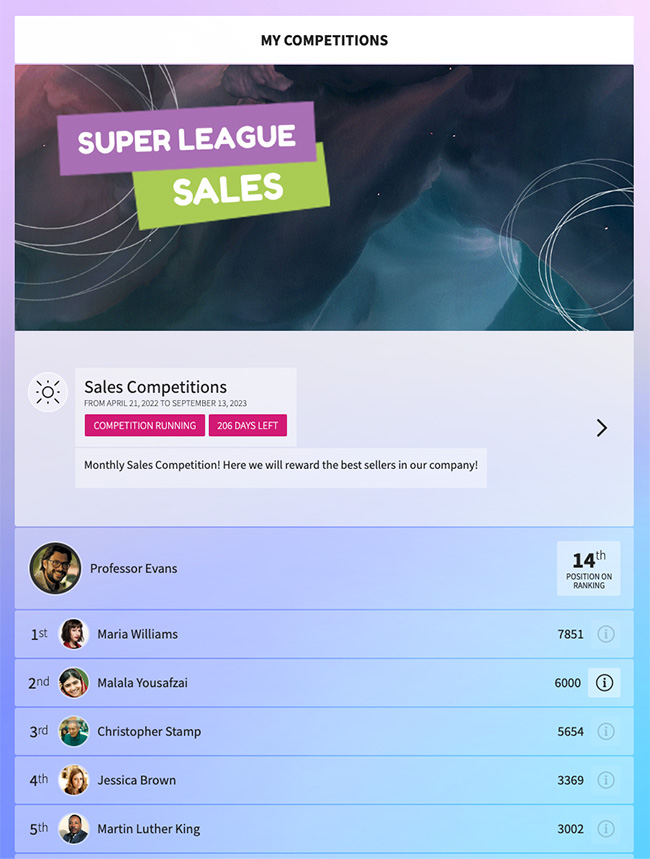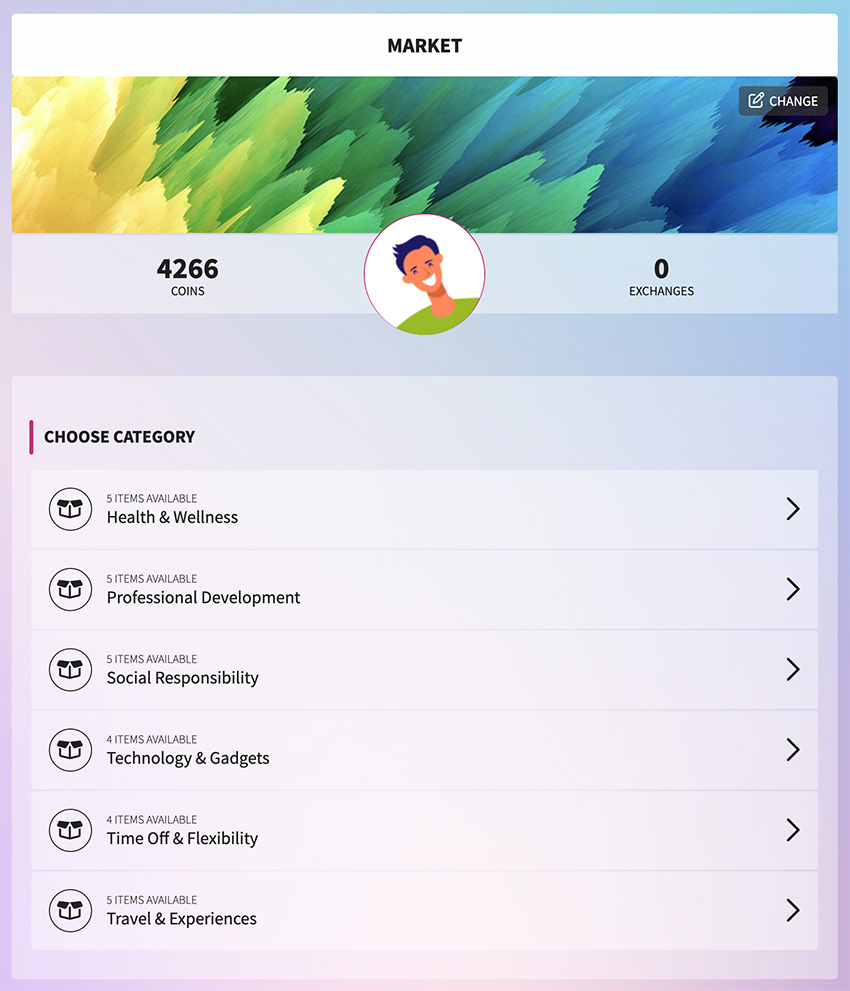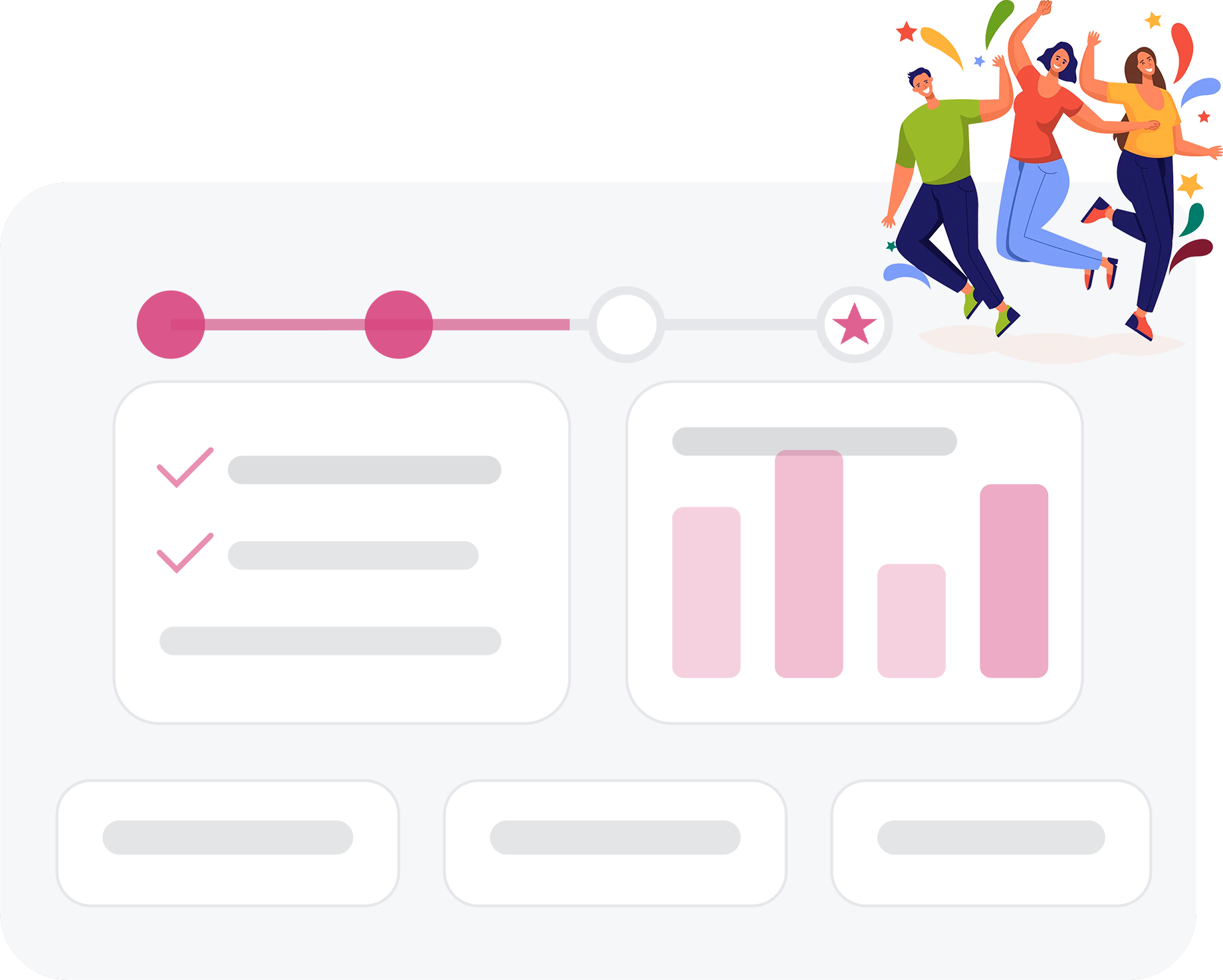What are compensation and benefits?
“Compensation” and “benefits” refer to the package of rewards provided by employers to their employees in exchange for their services.
Compensation and benefits are an important part of the employee experience. They can help attract and retain top talent, motivate and engage employees, and improve employee satisfaction.
When designing a compensation and benefits package, it is important to consider the needs of the employees and the overall goals of the organization. The goal is to create a package that is attractive to employees, but also affordable for the organization.
How GFoundry Can Help:
GFoundry’s comprehensive Talent Management Platform is designed to support organizations in navigating these challenges by offering tools that enhance the effectiveness of compensation and benefits strategies.
Through GFoundry’s gamification engine, companies can create dynamic and engaging reward systems that align with their compensation and benefits packages. Employees can earn badges, virtual coins, and other recognitions for achievements, contributing to a more motivating and rewarding work environment.
Moreover, GFoundry’s platform allows for seamless integration with existing HR and business intelligence systems, providing valuable insights into employee performance and satisfaction. These insights can inform compensation and benefits decisions, ensuring that packages are competitive and aligned with employee needs.
GFoundry also offers modules for continuous feedback and evaluation, enabling organizations to adapt their compensation strategies in real time based on employee input and market trends. By promoting a culture of recognition and providing structured paths for career development, GFoundry helps organizations foster a positive employee experience, ultimately leading to higher retention rates and a more engaged workforce.
 Some Statistics on Benefits and Compensation in Organisations:
Some Statistics on Benefits and Compensation in Organisations:
-
About 80% of employees would rather have new benefits than a pay rise;
-
72% of employees admit that an increase in non-monetary benefits would increase their job satisfaction;
-
Companies with more attractive benefits and compensation packages had a 53% decrease in their turnover rate;
-
79% of employees from Generation Z and Millennials recognise that an increase in their rewards for recognition would increase their connection with the company.
Source: Access Perks Blog
What are the differences between compensation and benefits?
-
Compensation:
- Direct Compensation: This refers to the monetary rewards given to employees for their work. Examples include:
- Salary: Regular payment, typically bi-weekly or monthly, that does not vary based on the number of hours worked (for salaried employees).
- Hourly Wage: Payments made based on the number of hours worked (for hourly employees).
- Commissions: Payments based on the volume or value of sales achieved.
- Bonuses: Additional payments beyond the regular salary or wage, often awarded for performance, achieving certain targets, or year-end.
- Tips: In some industries like hospitality, employees might receive tips from customers for good service.
- Indirect Compensation: Non-monetary rewards but still hold monetary value. Examples include paid time off, sick leave, or breaks during work hours.
- Direct Compensation: This refers to the monetary rewards given to employees for their work. Examples include:
-
Benefits:
- These are non-salary provisions that companies offer to employees to enhance their overall compensation package. Benefits can be legally mandated or provided as a competitive advantage by companies. Examples include:
- Healthcare Benefits: Medical, dental, vision insurances.
- Retirement Benefits: Contributions to retirement plans like 401(k) in the US.
- Insurance: Life insurance, disability insurance, etc.
- Paid Time Off (PTO): Vacation days, sick leave, personal days, etc.
- Employee Assistance Programs: Counseling services, legal advice, etc.
- Educational Assistance: Tuition reimbursement, professional development courses.
- Company Perks: Gym memberships, discounts, company car, etc.
- Stock Options: Offering employees the right to buy company stock at a predetermined price.
- Childcare: Some larger companies might offer on-site childcare or childcare subsidies.
- Flexible Working Arrangements: Flextime, remote working, compressed workweeks.
- These are non-salary provisions that companies offer to employees to enhance their overall compensation package. Benefits can be legally mandated or provided as a competitive advantage by companies. Examples include:
 Why are compensation and benefits important?
Why are compensation and benefits important?
Nowadays, most organisations have a Compensations and Benefits plan for their employees. These are not necessarily just monetary compensations.
The truth is that often a Compensation plan tailored to the needs and tastes of employees can have a significant impact on their motivation and therefore their productivity. Benefits can be linked to completing tasks and achieving certain goals, resulting in employees being more motivated to achieve certain rewards from your organisation.
If rewards are sufficiently aligned with employees’ tastes and profiles, they will feel more challenged and focused on achieving what is proposed. Furthermore, combining a compensation plan with gamification, you can make the employee experience more interactive, dynamic and, above all, rewarding of their effort.
One of the most influential levers a business can pull in achieving these objectives is its compensation and benefits package.
Here’s a closer look at the role of these elements and their far-reaching impacts on an organization:
Attracting high-performance candidates and improving retention
A robust compensation and benefits package acts as a magnet for top talents in any industry. High-performance candidates, often being in demand, can afford to be selective about their employers. Offering competitive salaries combined with a diverse array of benefits not only lures these candidates in but also plays a pivotal role in their decision to stay with the company for the long haul.
When employees recognize that their skills and contributions are being justly rewarded, they’re more likely to remain with the organization, reducing turnover rates and the associated costs of hiring and training new employees.
Motivated team members
Beyond just the basics of remuneration, benefits such as professional development opportunities, health and wellness programs, and flexible work arrangements provide employees with a sense that the company cares for their well-being and growth. This nurtures a motivated workforce, eager to contribute their best to the organization. When employees believe that they are fairly compensated and valued, they tend to push the boundaries of their roles, fostering innovation and driving growth.
Increased loyalty and engagement
An employee’s loyalty isn’t solely determined by their paycheck. Benefits that cater to an employee’s holistic needs – from health to work-life balance to future financial security – speak volumes about the company’s commitment to its workforce. Such provisions foster deeper loyalty, reducing the allure of headhunters and competitors. Moreover, loyal employees often act as brand ambassadors, promoting the company positively within their networks and potentially attracting more talent.
Improved productivity
It’s simple psychology: satisfied and engaged employees tend to be more productive. They are more focused, dedicated, and willing to put in the extra effort to see projects to fruition. By ensuring that the compensation and benefits align with or exceed industry standards, companies set the stage for an environment where employees are keen to deliver their best consistently.
Enhanced workplace experience
Lastly, compensation and benefits greatly influence the overall workplace experience. From the camaraderie formed in team-building events funded by the company to the peace of mind provided by a comprehensive health insurance package, these factors culminate in creating a positive, vibrant workplace culture. When employees are content and feel well taken care of, it permeates every aspect of the workplace, resulting in higher collaboration, fewer conflicts, and an environment conducive to growth.
 What are the components of nonfinancial compensation?
What are the components of nonfinancial compensation?
Employees are seeking more than just a good salary from their employers. Nonfinancial compensation, which refers to benefits and rewards that are not included in an employee’s basic salary, has become increasingly essential.
These compensations can significantly impact an employee’s satisfaction, engagement, and loyalty to a company. While some of these benefits have a clear monetary value, others are intangible and can still greatly affect an employee’s well-being and job satisfaction.
Benefits with a Monetary Value
1. Healthcare Coverage: While not directly adding to an employee’s paycheck, comprehensive health, dental, and vision insurance coverage can save employees a considerable amount on medical bills.
2. Retirement Contributions: Some companies offer retirement plans like 401(k) or pension plans where the employer contributes a certain percentage of the employee’s salary. Over time, this can lead to significant savings for the employee.
3. Educational Assistance: Offering reimbursements for courses or tuition can save employees thousands of dollars. This benefit not only provides a monetary value but also aids in personal and professional development.
4. Commuter Benefits: Some companies offer transit passes, reimbursements for parking, or even carpooling allowances, reducing the monthly commuting expenses of their employees.
5. Employee Discounts: Discounts on company products or services can save employees money, especially if these are products they use regularly.
Benefits with No Monetary Value
1. Flexible Working Hours: The ability to choose one’s working hours or work in a flexible environment, like remote working options, can greatly increase work-life balance without a direct monetary benefit.
2. Professional Development: Opportunities for training, attending conferences, or simply being given challenging assignments can boost an employee’s career trajectory. While these don’t have immediate monetary implications, they can lead to better career opportunities in the long run.
3. Recognition and Awards: Recognizing employees for their hard work and achievements, even if it’s just through verbal appreciation or awards, can boost morale and motivation.
4. Health and Wellness Programs: Initiatives like gym memberships, counseling services, or even organizing regular health check-ups demonstrate an employer’s commitment to their employee’s overall well-being.
5. Company Culture: A positive, inclusive, and vibrant company culture where employees feel valued and included can be a significant non-monetary benefit. It creates an environment where employees enjoy coming to work and interacting with their colleagues.
6. Work-Life Balance Initiatives: Measures like providing parental leave, counseling services, or even organizing team outings can assist in maintaining a harmonious balance between personal and professional life.
Compensation Metrics and Terms
To manage compensation effectively, it is essential to use key metrics that ensure fairness, transparency, and alignment with organizational goals. Below are some of the most important compensation metrics to track:
Salary Range Penetration
This metric measures an employee’s current salary as a percentage of the total salary range for their position. It helps ensure that salaries are competitive and consistent with the employee’s experience and performance levels.
Compa Ratio
Compa ratio is calculated by dividing an employee’s salary by the midpoint of the salary range for their role. A ratio below 1 indicates that the employee is paid below the market rate, while a ratio above 1 shows they are paid above it. This ensures alignment with market standards.
Range Spread
Range spread refers to the difference between the minimum and maximum pay within a salary range. A larger spread offers more room for salary growth, while a smaller spread can indicate limited progression opportunities within a role.
Range Maximum
The range maximum is the highest salary an employee can earn within their pay grade. It is crucial for managing expectations and planning promotions or salary increases over time.
Personalization of Benefits Packages
Comprehensive Benefits Packages Tailored for 50 Common Job Functions
| Job Function | Example Benefits Package |
|---|---|
| Accountant |
|
| Software Developer |
|
| Project Manager |
|
| Sales Manager |
|
| Customer Service Representative |
|
| Human Resources Manager |
|
| Marketing Specialist |
|
| Financial Analyst |
|
| Administrative Assistant |
|
| Operations Manager |
|
| Nurse |
|
| Teacher |
|
| Product Manager |
|
| Data Analyst |
|
| Business Analyst |
|
| Graphic Designer |
|
| Mechanical Engineer |
|
| Executive Assistant |
|
| IT Support Specialist |
|
| Logistics Coordinator |
|
| Digital Marketing Manager |
|
| Electrical Engineer |
|
| Quality Assurance Specialist |
|
| Procurement Specialist |
|
| Content Writer |
|
| UX/UI Designer |
|
| Network Administrator |
|
| Civil Engineer |
|
| Database Administrator |
|
| Social Media Manager |
|
| Biomedical Engineer |
|
| Compliance Officer |
|
| Event Planner |
|
| Web Developer |
|
| Pharmacist |
|
| Public Relations Specialist |
|
| Legal Counsel |
|
| Health and Safety Officer |
|
| Environmental Scientist |
|
| Supply Chain Manager |
|
| Construction Manager |
|
| Customer Success Manager |
|
| Copywriter |
|
| Clinical Research Coordinator |
|
| Technical Support Engineer |
|
| Manufacturing Engineer |
|
| Fundraiser |
|
| Actuary |
|
| Real Estate Agent |
|
| Account Manager |
|
 Trends in Compensation and Benefits
Trends in Compensation and Benefits
The Shift in Organizational Dynamics
Prioritizing Employee Experience
Trends in Compensation and Benefits
The Impact of Technology
The Evolution of Leadership
Embracing Change and Innovation
Investing in Human Capital
Purpose-Driven Organizations
3 Steps to create a Benefits and Compensation Programme
Here are 3 steps to help you effectively manage a Benefits and Rewards programme for your organisation:
Step 1: Measure
The first step in awarding compensation to employees who perform in line with your goals is to measure their performance.
Using Competition KPI’s with your data!
With the Competitions Module, you can gamify employee performance data in order to transform it into leaderboards. By giving visibility on the leaderboards, it is possible to implement a culture of healthy competitiveness, so that everyone wants to strive to reach the top!
Using Performance & Evaluation
With the our Performance & Evaluation solutions you can do continuous or one-off assessment to help you achieve goals and objectives throughout the year. In addition to performance evaluation, you can also manage your employees’ Potential and Career Management process. At this stage, responsibility is placed on the managers who are responsible for their teams, having a clear perception not only of each one’s performance, but also a perception of their potential within the organisation.
Using Recognition
Employee recognition isn’t just a nice-to-have. It also supports your organization’s bottom line. GFoundry’s recognition solutions enables peer-to-peer recognition and positive feedback to improve Engagement, powered by GFoundry’s gamification engine. With the GFoundry recognition module, you can endorse someone in your company in three possible ways: Public acknowledgment, Soft Skills Recognition and Hard Skills Recognition.


Step 2: Listen
Before defining what benefits can be given to employees, it is important to understand what benefits employees value the most. Depending on the community of each organisation, there are groups that have different preferences.
Using the Comparisons module
Through the Comparisons Module, you can give voice to the community and identify which benefits employees prefer most! Working through successive comparisons between two elements, employees answer and a ranking of preferences is generated for each employee. At the end, and after having the response of the whole community, a ranking of the organisation is generated, where it will be possible to identify the benefits most requested by employees!
Using the feedback module
Through regular feedback processes, you can see what things your employees value most. The feedback module allows you to create forms with multiple fields that can be segmented by department, job function, geography or any other group of people.
Step 3: Reward
In GFoundry, every action on the platform can be rewarded with a badge. Badges are an important element of our gamification engine that allows users to be awarded 2 very important elements: Points and Virtual Coins.
Points are used to position employees in Leaderboards.
Leaderboards promote a healthy competitiveness between people and teams as they give visibility to who is leading the top of the rankings in certain areas, which may be linked to Training, Recognition, among other modules. Virtual Coins represent the balance that each employee has on the platform, which can be used in the Market Module.
The Market Module works as a store, where the company can offer many benefits and perks that employees can exchange with their coins. Some examples of benefits can be vouchers, extra days of holidays or even contributions to social causes
It is also possible to integrate the virtual world with the organisation’s physical environment. Through Digital Vouchers, the company can distribute codes generated by the platform to various physical spaces, so that employees can exchange them for Virtual Coins. This way, you can manage, in a more agile way, all the benefits that you give to your employees, always having access to what they can earn throughout the year.

Subscribe to GFoundry Newsletter: Weekly Insights on HR’s Most Pressing Topics
Keep on reading:
- The Impact of Flexibility and Remote Work on Employee Satisfaction and Retention
- Mastering Employee Turnover: The Ultimate Guide to Retaining Talent and Boosting Productivity
- HR Trends: What Will HR Look Like Next Year?
- The Metrics and Emotions: Analyzing Pulse Surveys’ Dual Power
- How to improve Employee Engagement? Your Ultimate Guide
- Employee well-being – the complete guide
- How to Choose the Right Talent Management Platform for Your Business
- Recognition & Feedback
- Feedback: what it is, its importance and how to do it (complete guide)
Ready to get started?
Take the next step and learn more about how GFoundry can help you.
